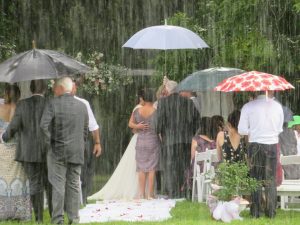What can go wrong?
When something is important to you, it’s likely that you’ll plan everything in detail so that it flows seamlessly and at the right time. In saying that, there are some things which can go wrong at a wedding but, with a little forethought, most of these can be avoided or at least smoothed over so that no-one is aware there was an issue. Here are a few of the ones I’ve experienced or heard about.
Someone is ill
Making a decision as to what to do in this situation is really up to the couple. If one of them is ill, the best course of action is to postpone the wedding and give your suppliers and guests as much notice as possible. After all, you want your day to be memorable for all the right reasons! When you’re ready to re-schedule, please check my availability early on and we can definitely make this happen! If it is someone close to the couple (such as a parent), the decision may be an equally difficult one to make. Just know that I will be super flexible with booking a new date with you.
Keep in mind, that your Notice of Intended Marriage is valid for a period of 18 months so, if it looks like your new date will fall outside this timeframe, you should lodge a new one with your celebrant at least a month beforehand so the last month of your original NOIM overlaps the first month of your new 1 month waiting period.
Rings
 First and foremost, it’s important to actually bring the rings to the ceremony! This is a key part of most weddings (although exchanging rings is not actually a legal requirement) so, unless you want to borrow and exchange someone else’s rings, it may mean a mad dash back to your accommodation if you forget them!
First and foremost, it’s important to actually bring the rings to the ceremony! This is a key part of most weddings (although exchanging rings is not actually a legal requirement) so, unless you want to borrow and exchange someone else’s rings, it may mean a mad dash back to your accommodation if you forget them!
Usually, it’s the Best Man’s job to take care of the rings. I’ve experienced them being left behind a couple of times but, so far, they’ve been retrieved safely, even if the bride had to go for a drive around the block before arriving!
Photo credit: Fiddle Leaf Photography
Another thing to avoid is dropping one or both rings. This happened at one of my weddings when one of the rings was whisked away on a gust of wind. When it was retrieved, and in order to lighten the moment, I remember saying something along the lines of “Ladies and gentlemen, that just goes to show that nothing of value will ever be lost from this marriage!” Everyone laughed and a crisis was averted.
If a little ring bearer is involved and they’re feeling a bit tired and overwhelmed, there is a chance that the ring box or pillow will be tossed, like confetti, as they’re walking down the aisle!
I recommend to my couples that they place both rings in the one box and, if a ring bearer is involved, that he delivers it to the Best Man at the start of the ceremony. The Best Man can then step forward at the appropriate time and present the rings by simply opening the box. The couple getting married then select their partner’s ring and hold it safely in their hand without two rings having to pass from the Best Man’s hand to their hands. Reducing the number of people handling the rings looks more seamless too.
If you have a young ring bearer, it makes sense to not give them the rings until just before they walk down the aisle and to always have a Plan B in mind in case they refuse to be involved!
Here’s a link to an earlier blog post on the exchange of rings.
Flower basket
In the same way that the rings can be tossed, so too can the flower basket! Sometimes, the contents of the flower basket can be emptied in the one spot, leaving nothing to scatter down the aisle!
To be honest, anything that involves children happens naturally and, if something does go awry, it almost always brings a smile to the faces of family and friends and can make a great (unplanned) photo opportunity.
PA issues
Sometimes there can be issues with a PA. I use a quality Roland system (often commented on favourably by musos at my weddings) and am confident with how it works. I have had a couple of occasions since becoming a celebrant back in 2013 where there has been interference from someone else using the same frequency but, if these things can be checked out before family and friends arrive, Plan B can be employed.
Supplier double books
Sadly, this can happen. I had a photographer turn up an hour late for pre-wedding photos recently because she had the wrong date in her calendar and had to be tracked down at work! It meant the time available for photos before the ceremony was shortened and the ceremony itself was delayed 20 minutes or so.
For me, it’s important to keep regular contact with my couples and use the date and time of the wedding in the subject line of my emails and in the draft ceremony I send through for review.
I also keep an electronic diary plus a hard copy diary noting every single booking and appointment. In addition, each couple’s individual file is placed in date order in my filing cabinet. In this way, I have a 3-step system for checking dates and availability.
Communication
I let my couples know that it’s really important they advise me of any changes, in writing, when they occur and that I will confirm receipt of these changes, also in writing. Even the smallest detail can make a big difference to our planning.
I always write to couples on the morning of their wedding and it was on one such occasion that I was told that the wedding had been brought forward by 30 minutes! It may not seem a big issue as I always arrive around 45 minutes prior to each ceremony but that’s because I like to be organised and set up well in advance. I subsequently discovered that everyone else knew about the change, except me (the person who makes it all official!) Advising me had just been overlooked. All was good in the end but it confirms the need to keep in touch on a regular basis.
You can read further on the topic of keeping on track with your celebrant by heading over here:
Wardrobe malfunction
At a recent wedding, one of my brides arrived 30 minutes late due to a wardrobe malfunction with one of her bridesmaids’ dresses. This is when an emergency kit, including needle and thread or even tiny safety pins, can come in very handy!
Wet weather

The weather is the one thing we have no control over. When choosing an outdoor location for a wedding, it’s important that a backup plan be available so that all your key suppliers can set up in good time and your family and friends can enjoy the celebration under cover.
Sometimes, however, the ceremony is already underway when the heavens open. In this event, it’s important to (safely) re-locate somewhere under cover so that the ceremony can be concluded there. Having the bridal party, celebrant and guests get cold due to wet clothing, hair and shoes is not conducive to a great celebration although, sometimes, the photos can be epic!
I always think it’s best for someone to be nominated to make a call at a particular time (and stick to it!) so that everyone is clear on when to change to Plan B.
When the rain (pictured above) started falling heavily during one of my ceremonies, we had Plan B ready nearby and re-located to the safety of the marquee.
Tides
Don’t forget, if you plan to marry on the beach, always check the tidal information. This may well have a huge impact on where the ceremony takes place. It takes time to re-locate seating, an arbour, signing table, aisle runner etc. so making plans to set up well out of the reach of the water is key. Remember, everyone will need to return to their cars after the ceremony so there must be an exit plan too!
An unexpected plus one
This is something that most people know not to do as seating and catering is all centred around final numbers. Perhaps, if you find yourself in this situation, you may need to re-evaluate your friendship with the person you invited. There really is no excuse for bringing a plus one if they’re not specified on the invitation.
Discord between family members or guests
Hopefully, those who are invited to your wedding will come on their best behaviour. If, however, there is any lingering discord between people, it’s always a good idea to plan what you might do. Allocating someone to act as go-between, employing a security guard, and ensuring bar staff are aware of anyone whose alcohol intake may need to be watched, are all options.
In summary
When you think about what can go wrong, I believe it’s important that each supplier involved is flexible and can come up with creative solutions if needed. Visiting each location prior to a ceremony is always a good idea. Otherwise, you may not realise there is a long flight of stairs down to the beach, for instance, and a guest who is disabled is unable to get down there.
As a celebrant, it’s vital that the legal wording is included in each wedding so that the couple is married according to the Marriage Act 1961. Other than this, it’s our job to be professional, think on our feet, ad lib if needed, and ensure each couple is happy with the service we provide.
When what can go wrong does go wrong, and you’re able to come up with a backup plan quickly, you may well find that family and friends are completely unaware that any adjustments had to be made at all.

28/05/2022
090 ~ © Lindy Cooke Celebrant
